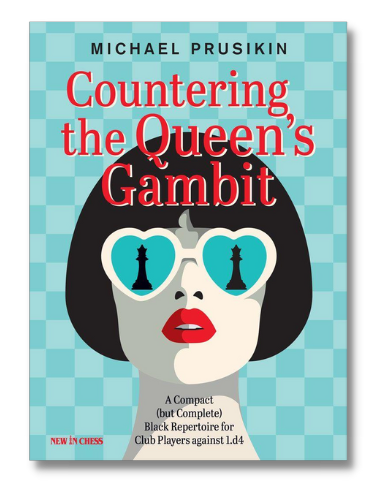Book Review of Countering the Queen’s Gambit
“As a result of the minority attack, Black will be left with at least one weak pawn. If he is not to sink deeper into positional disadvantage, Black must look for counter-chances.”
– Former world champion Max Euwe, in his book The Middle Game, Book 1, Bell and Sons.
The Queen’s Gambit Declined (1.d4 d5 2.c4 e6) has a curious existence. It’s a trusted defense for grandmasters and world champions alike (including Magnus Carlsen), but it’s often shunned as a defense by club players. Part of the problem may be all those White 1.d4 repertoire books that give the same recipe for White against this defense:
- Play the Exchange Variation (3.Nc3 Nf6 4.cxd5 exd5).
- Initiative a queenside minority attack.
- Tie Black down on the queenside, eventually win a pawn there, and use the extra pawn to later win the game.
It’s an easy recipe, but surely that can’t be the whole story, as otherwise why would anyone (including the world champion!) play this defense against 1.d4? And of course, it isn’t the whole story as Countering the Queen’s Gambit clearly shows. The key for Black in this variation is Euwe’s recipe in the quote above: seek counter chances.

The author of this book, GM Michael Prusikin, writes:
“The reasons for the eternal popularity of the Queen’s Gambit Declined lie in the nature of this opening. It offers Black reliability without depriving him of winning chances and relies more on an understanding of the type of positions that arise than on memory.”
He also writes:
“The repertoire presented here has served me well at grandmaster level for decades – I trust it! Club players need only master a small number of the variations, and these are summarised in the list of variations. The move orders analyzed in the text will help you to understand the typical positions, plans, and tactical ideas.”
It’s always very useful when the author of an opening book uses the systems that he recommends, as he has detailed knowledge of what works, and perhaps more importantly, what doesn’t work.

The book is divided into four parts. The first part discusses the key ideas and pawn structures of the Exchange Variation and the Tartakower Variation (3.Nc3 Be7 4.Nf3 5.Bg5 h6). The Tartakower is a very solid variation that was a particular favorite of former world champions Spassky and Karpov, and it is still used by top players. Part 2 covers the detailed theory of the Queen’s Gambit Declined, including the Catalan, and this part complements the general discussion in Part 1.
Part 3 offers a compact repertoire against other first moves by White except for 1.e4, including the mainstream Réti and English Openings, and less-common openings such as Bird’s and Larsen’s Openings, and even the Grob (1.g4)! Here, Prusikin offers suggestions that complement the rest of the repertoire, and this means using 1…d5 whenever possible, except for against 1.b4, where he recommends 1…e5. The final part of the book contains 36 exercises for readers to solve, together with detailed solutions.
In general, the author suggests practical choices that minimize the amount of work for the reader to study, while maintaining a sound repertoire. However, he doesn’t shy away from offering aggressive choices where appropriate. Prusikin provides very clear commentary on the variations, and he includes key tips and ideas throughout the book. The typical plans are highlighted through a good selection of illustrative games, including some by the author, and many correspondence games since these games generally involve deep analysis of the variations.
An example from the book is given below, with annotations from the book.
Countering the Queen’s Gambit Illustrative Example
The game commentary in this example shows that the author provides a balanced approach to the repertoire and shows where both sides could have improved or where the resulting positions are balanced. This is much more acceptable than misleading readers by erroneously claiming that the suggested repertoire is a virtually forced win for the repertoire side.
The subtitle of the book is “A Compact (but Complete) Black Repertoire for Club Players against 1.d4”, and the book certainly lives up to this claim, although the repertoire is actually much broader than this! The author has compiled a sensible repertoire without overwhelming the reader with far too much detail. All this is achieved in under 200 pages of theory, which is quite a feat. Provided readers are prepared to update the suggested repertoire with more recent developments as theory inevitably marches on, it’s a repertoire that is sound and can be used for a lifetime.
Have any thoughts or questions? Let us know in the comments below!
- 1000 Published books on Forward Chess - November 15, 2024
- Book Review: A Guide To Chess Improvement - September 9, 2024
- Review: Chess Coach by Vladimir Barsky - August 26, 2024
